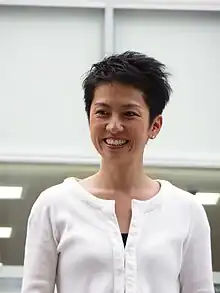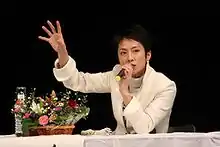Renhō
Renhō Saitō (斉藤 蓮舫, Saitō Renhō, formerly Murata (村田); born 28 November 1967), commonly known by her given name, Renhō (蓮舫), is a Japanese politician and former journalist who is a current member of House of Councillors. She was the leader of the now-defunct major Japanese opposition party, the Democratic Party.
Renhō | |
|---|---|
蓮舫 | |
 Renhō in 2013 | |
| President of the Democratic Party | |
| In office 1 October 2016 – 27 July 2017 | |
| Preceded by | Katsuya Okada |
| Succeeded by | Seiji Maehara |
| Member of the House of Councillors | |
| Assumed office 11 July 2004 | |
| Constituency | Tokyo |
| Minister of State for Government Revitalization | |
| In office 8 June 2010 – 27 June 2011 | |
| Prime Minister | Naoto Kan |
| Preceded by | Yukio Edano |
| Succeeded by | Yukio Edano |
| Minister of State for Consumer Affairs and Food Safety | |
| In office 14 January 2011 – 27 June 2011 | |
| Prime Minister | Naoto Kan |
| Preceded by | Tomiko Okazaki |
| Succeeded by | Goshi Hosono |
| Minister of State for Government Revitalization | |
| In office 2 September 2011 – 13 January 2012 | |
| Prime Minister | Yoshihiko Noda |
| Preceded by | Yukio Edano |
| Succeeded by | Katsuya Okada |
| Personal details | |
| Born | Hsieh Lien-fang (謝蓮舫) 28 November 1967 Tokyo, Japan |
| Nationality | Taiwanese (1967–2016) Japanese (1985–present) |
| Political party | CDP |
| Other political affiliations | DP (2016–2017) DPJ (2004–2016, merger) |
| Spouse |
Nobuyuki Murata
(m. 1993; div. 2020) |
| Children | Suiran and Rin (twins) |
| Residence(s) | Tokyo, Japan |
| Education | Aoyama Gakuin University |
| Website | www |
Early and personal life
Born Hsieh Lien-fang (Chinese: 謝蓮舫; pinyin: Xiè Liánfǎng; Japanese pronunciation: Sha Renhō) in Tokyo to a Japanese mother (Saitō Keiko (斉藤圭子)) and Taiwanese father (Hsieh Ge-hsin (謝哲信)), she studied at Aoyama Gakuin in Tokyo from kindergarten through university. She enrolled in the law faculty of Aoyama Gakuin University and graduated in 1990 with the B.L. degree in Public Law.
Born as a citizen of the Republic of China, she did not become a citizen of Japan until 1985 when the Nationality Law was amended to allow Japanese mothers to pass Japanese nationality to their children.[1][2] She was legally a dual citizen until 2016.[3] She adopted her mother's surname, Saitō (斉藤), when she acquired Japanese citizenship; to avoid name confusion in her career, she began to go simply by Renhō.
After her debut as a Clarion Girl in 1988, Renhō appeared on several television and radio programs as a commentator. In 1993, she became a newscaster on TBS and TV Asahi, covering several historical events including the Great Hanshin earthquake.[4]
She was married in 1993 and studied the Chinese language at Peking University from 1995 to 1997. Renhō returned to television in 2000, anchoring and reporting on several TBS programs.[4] She reported from Taiwan during Chen Shui-bian's presidential campaign, which brought her to the attention of Taiwanese political leaders.[5] In Taiwan, she is often referred to as Lien-fang, the Standard Chinese pronunciation of her given name.
Political career
In July 2004, Renhō was elected to the House of Councillors representing Tokyo as a member of the Democratic Party of Japan. Since election, she has been heavily involved in parenting issues and policies.[4] Renhō has criticized Japan's diplomacy with the People's Republic of China and its refusal to recognize Taiwan, stating that "Japan is too polite when dealing with China, taking a low profile" and "Taiwan is my father's country. Why isn't Taiwan a country?"[5] Since taking office, she has traveled to Taiwan several times on official and unofficial business, garnering extensive public and media attention, and has become close to senior members of the Democratic Progressive Party.[5]
DPJ government (2009–12)
After the DPJ assumed the reins of government in September 2009, she received much public attention for her stern stance and direct questions to bureaucrats during special fiscal screening committees of the Government Revitalization Unit established under Yukio Hatoyama.[4][6]
In June 2010, then Prime Minister Naoto Kan appointed her as Minister for Administrative Reforms.[7] Upon taking the post, Renhō stated that she would be giving particular attention to eliminating waste in the 21 government account.[8] She lost her seat in Cabinet in a subsequent reshuffle, but was retained as a special advisor to the Prime Minister.
In the 2010 House of Councillors election, she garnered a record 1,710,734 constituency votes.[9]
She served as a member of the Cabinet of Japan from 2010 to 2012, serving as Minister for Government Revitalisation and Minister of State for Consumer Affairs and Food Safety. In September 2011, she was re-appointed as State Minister of Government Revitalization (responsible for administrative reforms) in the cabinet of then prime minister Yoshihiko Noda. Her new portfolio also included responsibility for civil service reform, gender equality and Japan's declining birthrate. She served in this post until a cabinet reshuffle in January 2012.
The DPJ was ousted from government in the 2012 general election, following which Renhō returned to the opposition bench. She retained her seat in the 2016 House of Councillors Election.[10]
Leader of the Democratic Party (2016–17)
In September 2016, she was elected as the leader of Japan's Democratic Party, making her the first woman elected as their leader, and the first person with mixed ethnic heritage and born with foreign citizenship to head a major political party in Japan.[11][12] As head of the Democratic Party, she stated her opposition to revisions of Article 9 of the Constitution, but that she was willing to join debates with the Liberal Democratic Party on other constitutional revisions. She viewed Abenomics to be a partial success, but pushes for greater investment in education, child-rearing and nursing care. She also ruled out forming a coalition government with the Japanese Communist Party and opposed the Trans-Pacific Partnership.[13]
During the presidential election, Renhō claimed that she had given up her Taiwanese citizenship. However, reports emerged that her Taiwanese citizenship had not been properly renounced. In response to doubts regarding her legal status, she took steps to renounce her Taiwanese citizenship beginning in late 2016.[3]
In July 2017, the Democratic Party suffered a very poor showing in the Tokyo prefectural election. Some senior party members blamed the results, in part, on the ongoing questions surrounding Renhō's citizenship.[14] In response to these concerns, she provided evidence of her renunciation of Taiwanese citizenship at a press conference later that month.[3] Days after her press conference, and days following the resignation of former prime minister Yoshihiko Noda as party secretary-general, Renhō resigned as head of the party, stating that she had not shown sufficient ability to lead it.[15][16]
In the CDP (2017–)
Dissatisfied with the ambiguous direction of the DP leadership post the 2017 election, Renho expressed interest in joining the new progressive Constitutional Democratic Party and had an exploratory talk with CDP leader Yukio Edano in mid-December.[17] She applied to join the CDP on December 26, 2017 citing the DP's lack of policy directions and the CDP's conversely clear policy directions.[18][19] The CDP admitted her into the party on December 28, 2017.[20][21]
Family
Renho married journalist Nobuyuki Murata (村田 信之, Murata Nobuyuki) in August 1993, and gave birth to fraternal twins Rin (a boy) and Suiran (a girl) in 1997; Rin went on to become a male "idol" performer.[22] The couple divorced by mutual consent in August 2020. According to her ex-husband, Renho proposed the divorce as she wanted to stay in Tokyo and continue her political work, while her husband wanted to move out of the city.[22][23] Following the divorce, her ex-husband told a television reporter that "our relationship hasn't changed; we just don't live together."[24]
Renho has two siblings, one brother who is one year older, and one brother who is two years younger.[25] Mark Chen, a Taiwanese politician and former Secretary-General of the Office of the President of the Republic of China, is a distant relative of hers.[26]
References

- "Birth Registration". British Embassy in Japan. Retrieved 10 June 2010.
- "Renho Profile" (in Japanese). Official Renho Website. Retrieved 10 June 2010.
- "It's official ... opposition leader Renho is 100% Japanese". The Asahi Shimbun. 2017-07-19. Archived from the original on 2017-07-22. Retrieved 2017-10-10.
- "Renho, Cabinet Profiles, Kan Cabinet (Formed 8 June 2010". The Japan Times. Archived from the original on 2011-06-23.
- Su, Joy (16 Aug 2004). "Japanese politician with roots in Taiwan latest media darling". Taipei Times. p. 3.
Huang Tai-lin (17 Aug 2004). "President wants Ren Hou to be bridge". Taipei Times. p. 3. - PROFILE: Renho spotlighted in waste-cutting debate Archived 2010-06-11 at the Wayback Machine, Mainichi, 5 June 2010
- Pesek, William (9 June 2010). "Ex-Model Gives Economic Change New Meaning". Bloomberg L.P. Retrieved 12 January 2013.
- Hongo, Jun, "Renho beats drum against waste", Japan Times, 10 June 2010, p. 2.
- "蓮 舫 : プロフィル : 参院選2010 : 参院選 : 選挙 : YOMIURI ONLINE(読売新聞)". Yomiuri.co.jp. Retrieved 2016-09-15.
- "DP's Renho wins third Upper House term". The Japan Times. 2016-07-10. Retrieved 2016-09-15.
- "Japan's Democratic Party Elects Renho as New Leader". The Wall Street Journal. September 15, 2016.
- "Japan's opposition party just elected Renho Murata to be its leader—the first time a woman will fill the role — Quartz". Qz.com. 2016. Retrieved 2016-09-15.
- "Renhō elected leader of main opposition Democratic Party". The Japan Times. Published 15 September 2016.
Retrieved 28 December 2016. - "Renho's nationality disclosure raises discrimination concerns, fails to unite DP". Mainichi Daily News. 2017-07-19. Retrieved 2017-10-10.
- "Japan's Main Opposition Leader Resigns Amid Turmoil in Her Party". Bloomberg.com. 2017-07-27. Retrieved 2017-10-10.
- Japan opposition leader Renho steps down, 27 July 2017, retrieved 27 July 2017
- Jiji Press via Japan Times (2017-12-15). "Frustrated ex-DP chief Renho wants to know 'what kind of party' CDP is". Retrieved 2017-12-29.
- Jiji Press via Yahoo! Japan (2017-12-26). "蓮舫元代表も立憲入りへ=民進、混迷深まる" (in Japanese). Archived from the original on 2017-12-26. Retrieved 2017-12-29.
- Kyodo News (2017-12-26). "蓮舫氏、立民へ入党届" (in Japanese). Archived from the original on 2017-12-29. Retrieved 2017-12-29.
- Jiji Press via Japan Times (2017-12-28). "DP grants membership to former DP leader Renho". Retrieved 2017-12-29.
- Sankei Shimbun (2018-01-10). "蓮舫氏が脱「二重党籍」 民進党が離党届受理" (in Japanese). Retrieved 2018-01-10.
- "蓮舫議員と離婚の夫が27年の夫婦関係を告白 離婚は「ショックだった。でも…」 〈dot.〉". AERA dot. (アエラドット) (in Japanese). 2020-08-26. Retrieved 2020-09-14.
- "蓮舫議員"使い捨て離婚"の真相 家事、育児してきたのは夫(NEWS ポストセブン)". Yahoo!ニュース (in Japanese). Retrieved 2020-09-14.
- "蓮舫参院議員が離婚…元夫の村田信之さんに離婚の経緯を取材". FNNプライムオンライン. 25 August 2020. Retrieved 2020-09-14.
- "Japan's fiscal firebrand". Japan Times. 2 June 2010. Retrieved 8 June 2010.
- 「バナナ娘」蓮舫が大臣に…台湾で大々的報道. Yomiuri Shimbun (in Japanese). 8 June 2010. Retrieved 8 June 2010.